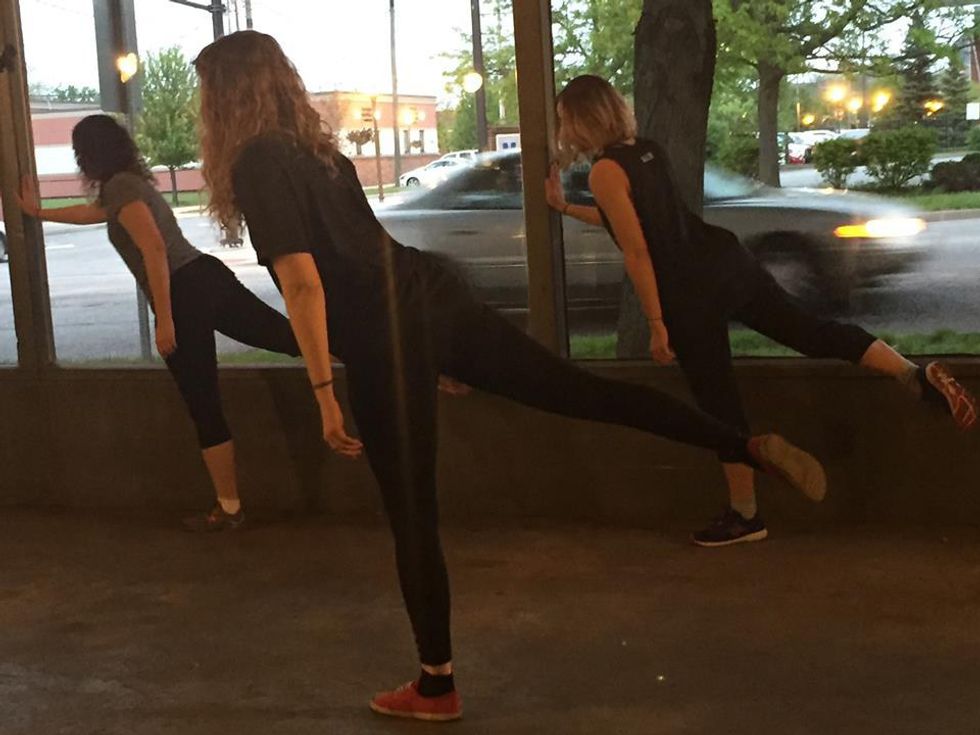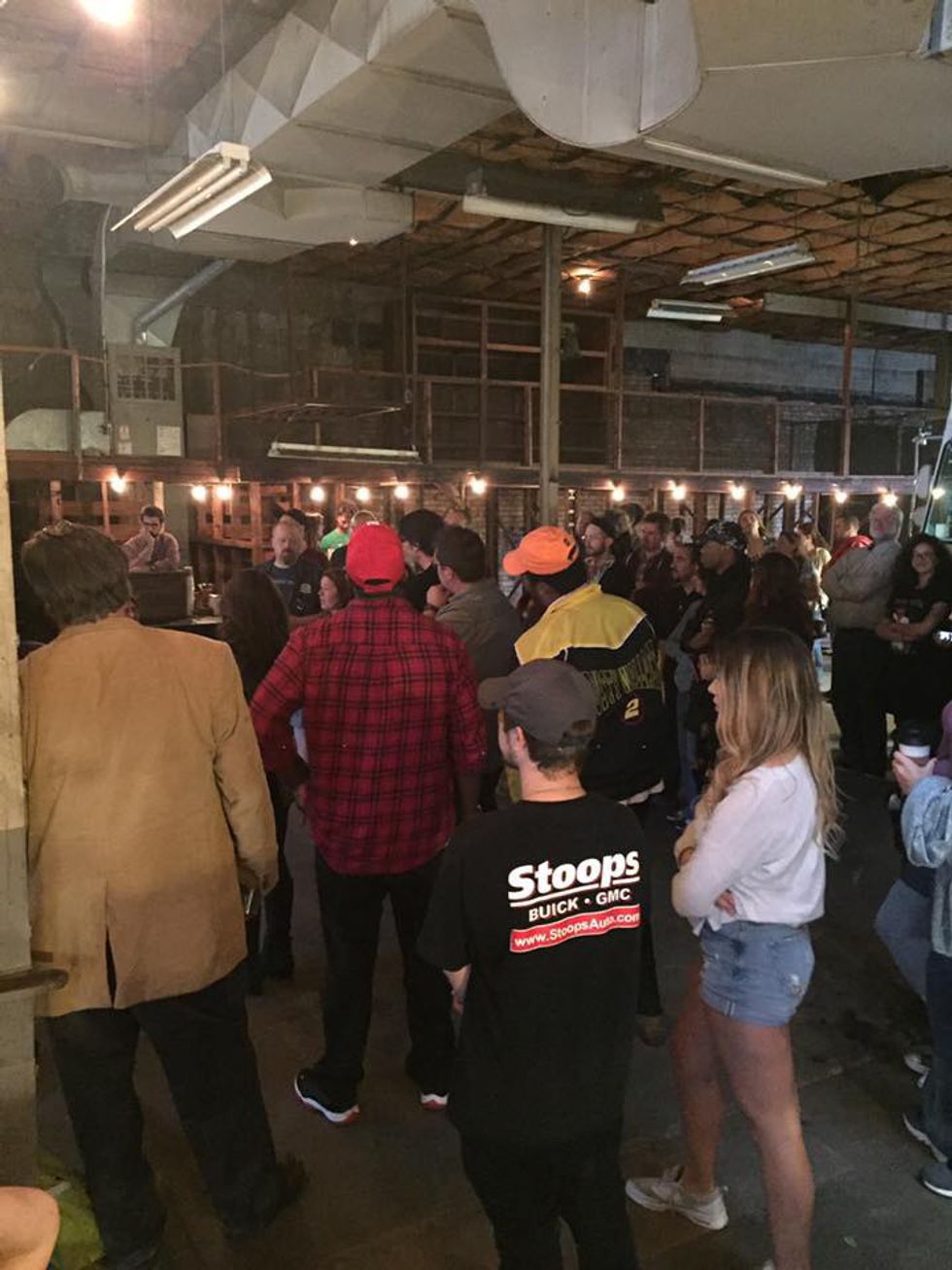Works In Progress took place on Friday, May 13, at the J.C. Lauber building in South Bend, Indiana. Marketed as a mixer-turned-dance-party, the old sheet metal factory turned into an impromptu arts venue for the evening and invited those in the South Bend community to engage with local artists and entrepreneurs.
The concept “in progress” represented an idea that working artists could create their craft in front of patrons in real time. For example, dancers from Fischer Dance rehearsed and set movement sequences while in the space, allowing the audience to witness a process that usually occurs only behind closed doors.
Friday’s event was open to all ages and included multimedia artist Terrible Tony and ceramicist Paul Kuharic, along with music from DJ Chuck Fry and local products from Make South Bend. Beverages were provided by South Bend Brew Werks and Zen Café and food could be purchased from local food truck The Grateful Green.
Hosted by The Birdsell Project and Fischer Dance,
the evening commenced with a discussion on the State of Art in South
Bend. The discussion was open to all participants and addressed many concerns of artists, entrepreneurs, and community members alike.
The takeaways from the discussion are worth being made public for
further consideration and conversation.
This type of event, bringing together various artists and local businesses, is not uncommon for South Bend. For the past few years, these sorts of community events have been occurring more and more frequently. The willingness to give funds back to the community to initiate the type of city we want to live in and contribute to was a common sentiment expressed by many of the local entrepreneurs who attended the event, such as Andrew Elegante from Brew Werks and Myles Robertson from The Birdsell. But the capability to do this with the visual arts, and how to be more inclusive of everyone in the community while meeting the needs of a wide audience, is something still in need of improvement and continued speculation.
The pre-event discussion focused primarily on visual arts in South Bend, as it was immediately agreed upon that this scene is more often underrepresented. One of the first comments was made by Elegante, who remarked that the music scene in South Bend is popping, but what about the visual arts? Below is a summary of some of the general ideas and generated from the dialogue.
Marketing is an issue and a central calendar for art events could be helpful.
As expressed by many attendees, there are often multiple events happening on the same night. However, these events are usually marketed separately and it can sometimes be difficult to keep track of everything happening on the same evening. As a result, one must pick and choose events, sometimes not realizing the possibility to attend all of them. The idea of compiling a calendar which included all of the arts events happening in South Bend for the week or the month could help all of the events to be equally well-attended. The lack of events is not really the issue, but how to get to all of them is a greater issue.
Walkability is something that limits our community in South Bend.
One community member pointed out how walkability is a major factor of consideration for her. If events were in a walkable distance, then many events could be visited in an evening out with family or friends. But often, events are farther apart, forcing community members to pick between all of them.
Performance space is an issue.
When thinking about arts like dance specifically, performance space is often a bit difficult to find. There are plenty of spaces in the area linked to the universities, such as Indiana University South Bend and Notre Dame, as well as the Morris Performing Arts Center. But all of those spaces are a bit more high-end. And for local community artists working on low budgets, those spaces do not work. Could anything be done in our community to create more performing spaces, or to make already existing spaces more accessible?
Diversity works in marketing and increasing attendance.
It was pointed out by one man that when a single event brings in a diverse array of artists, it seems to work well. Works In Progress is an example of just that concept—bringing together visual artists from different mediums. But the question is one of frequency. How often do events occur which cater to such a varied audience?
There are gaps in diversity.
In contrast, diversity seems to be lacking in a different way. It was pointed out that the audience at Works In Progress was a mostly white, young-adult audience. How could the community appeal to and engage more people from different racial, ethnic, and socioeconomic backgrounds, and include all ages? It was discovered in our talk that we do not as of yet have many concrete solutions in addressing issues like this, and sometimes it is even a sensitive topic.
As I talked to others in the audience throughout the course of the evening, I sensed some concern from the members of the older generation. For them, their biggest critique was the manner of marketing. There was marked concern that today, and among those in the younger generation, a primary tool for marketing is social media. Yet this is both a blessing and a curse.
Social media functions as one of the best ways to pull in an audience, especially when platforms like Facebook will create lists of events and reminders for its users. However, it was said that some in the older generation either do not have computers or do not use social media at all. They desired to see other forms of advertisement in South Bend that could draw in people of their own age set.
Despite everything, those in South Bend still experience a sense of possibility here that they believe they would not be able to find elsewhere. While the ideas discussed are still in high demand for local conversation and solution, the push to continue community engagement in visual arts remains intact.
Be looking for two more Works In Progress events to occur this summer (June 10 and July 8), before a full production is revealed by Fischer Dance in August.



















